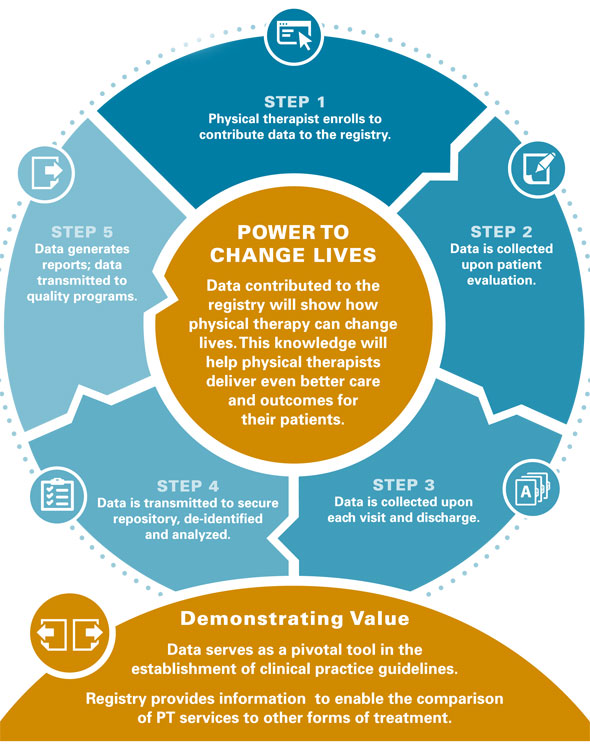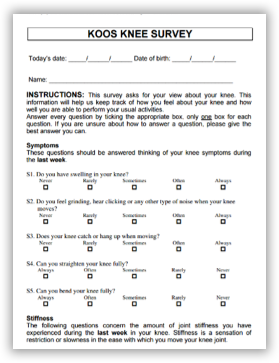
Blogger: Katie Baratta
My name is Katie Baratta and I just graduated from the Regis University School of Physical Therapy. I had the opportunity to spend two weeks at the APTA doing a student internship. I was able to talk to many different members of the APTA, attend the Federal Advocacy Forum, and learn more about what the APTA has been doing to move our profession forward. I’ve written a series of essays about my experiences here at the Association.

Data… I love it! As a former engineer who analyzed a lot of data in my pre-PT life, I find it fascinating to see how lots of tiny bits of information, combined together, can provide us with a more comprehensive picture.
The PT Outcomes Registry is one of APTA’s current projects to create a centralized database for outcome data. The idea is to track a set of prioritized outcome measures (currently there are nine outcomes, but this may expand) across the country. Clinicians perform the outcome assessment with the patient at the initial evaluation and again at discharge to measure the patient’s progress and then input the information into the computerized system. The PT Outcomes Registry then compiles the data from all practitioners so that practitioners can see how they measure against a benchmark of other providers.

Timeline
The program is still in its pilot phase with 216 enrolled users (currently all practicing PTs, no PTAs) at 25 organizations. The most recent development is to include residents and fellows to compare their outcomes both during their residency/fellowship and again afterward to see how their outcomes change with time and experience. Later this year, APTA will collect feedback via user survey of pilot users regarding usability, pros/cons, glitches, and so forth. The team at APTA will then incorporate this feedback into the PT Outcomes Registry system.
The Registry will officially launch at the beginning of 2017, at which time any clinical site will be able to join. Clinicians will pay to enroll in the program, which will give them access to the aggregated data to see how their practice stacks up against national benchmarks. The service will not be limited to APTA members. Karen Chesbrough, the outcomes registry director, states that by the end of 2017 the APTA would love to have 1000 users, with the long-term goal of involving as many clinicians/sites as possible to get as accurate a picture of current practice as possible.
Which types of data are included?
The current outcomes include global measures, such as AM-PAC™ (Activity Measure for Post-Acute Care™), PROMIS (Patient Reported Outcomes Measurement Information System), and OPTIMAL (Outpatient Physical Therapy Improvement in Movement Assessment Log). There are also regional/body-specific outcome measures such as NDI and Oswestry. Other data includes clinician profiles, patient demographics, and pain ratings; practitioners have the ability to enter data at treatment visits along with at initial evaluations, reassessment, and discharge. The types of outcomes included are vetted through an independent group of clinicians and academics (including one Canadian!) called the Scientific Advisory Panel.
The Scientific Advisory Panel is working in conjunction with the SIGs (Special Interest Groups) to develop prioritized objective data that the clinician would also collect as part of the PT Outcomes Registry based on the patient’s diagnosis. These modules may be specific to cervical pain or to infant torticollis, for example, and would include relevant ROM or other objective data.

How does PT Outcomes Registry collect the data?
During the pilot program, enrollees are entering the data manually. Enrolled clinicians—or their clinic’s administrative support personnel—will log in to the system and select different tabs and boxes to enter the data, much like they do for electronic documentation of patient records.
However, manual data collection is time-consuming, so the current push within the project’s development is to build software “bridges” with all of the various EMR (electronic medical records) systems. These bridges would allow a computer program to connect the PT Outcomes Registry with each EMR system to pull the relevant pieces of data into the database. Each type of information (eg KOOS at initial eval, patient age, etc) will have an associated tag in the registry database, and each EMR will tag the same variable in their database so that the computer program will be able to match the data from the patient records to the PT Outcomes Registry. One EMR has already signed on to the project, and APTA is working to get more to participate. This will streamline the process significantly and will likely increase participation as less time and energy will be required for individual clinicians to enter the data by hand.

What does this mean for clinicians?
Being a part of the PT Outcomes Registry would allow clinicians to see how their practice stacks up against others throughout the country. If a particular clinic performed very favorably within the Registry, it would be able to advertise this fact to patients and to different entities that may want to contract with the clinic. Participation in the PT Outcomes Registry would also enable a clinic to pinpoint how to improve poor performance in a particular area that they may not have previously recognized without the aggregate data.
The PT Outcomes Registry will provide objective information to support the assertion that PT restores function. We can then use this information to demonstrate our value to different organizations, whether that is with a hospital, an insurance organization, or to the general public.
The outcomes registry director also sees this information as eventually being linked to reimbursement. Linking outcomes to reimbursement would continue the trend to move away from fee-for-service and toward a value-based payment structure. A value-based payment structure rewards effective clinical practice, rather than performing treatment units with the highest reimbursement rates. This would be a win-win for evidence-based practitioners, as well as for their patients.
Eventually, with enough data, there is potential for the information to be used for research as well; the Outcomes Registry represents the exciting future of our profession!
PT Outcomes Registry Site | More info from the APTA
Pingback: Physical Therapy Outcomes Registry
Pingback: Physical Therapy Outcomes Registry – Betty Roche